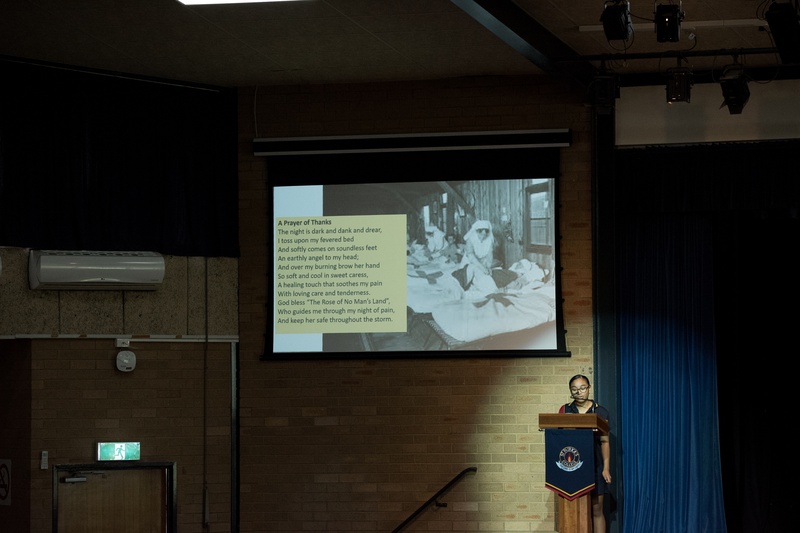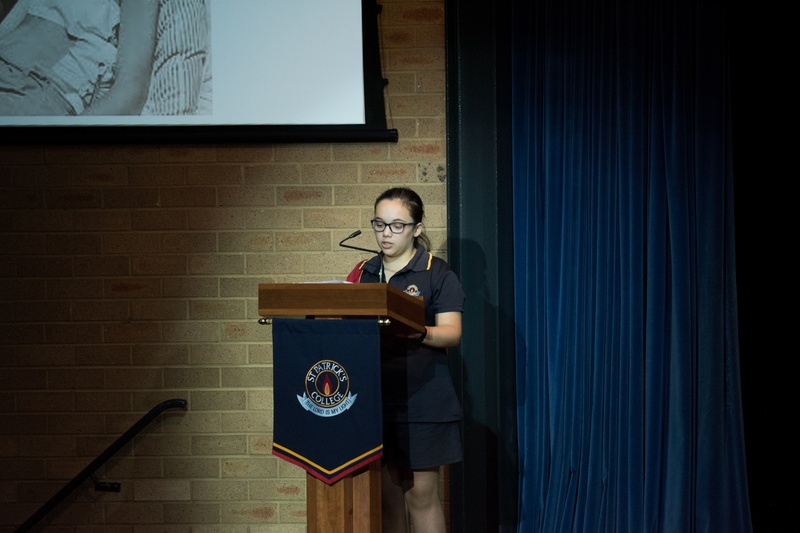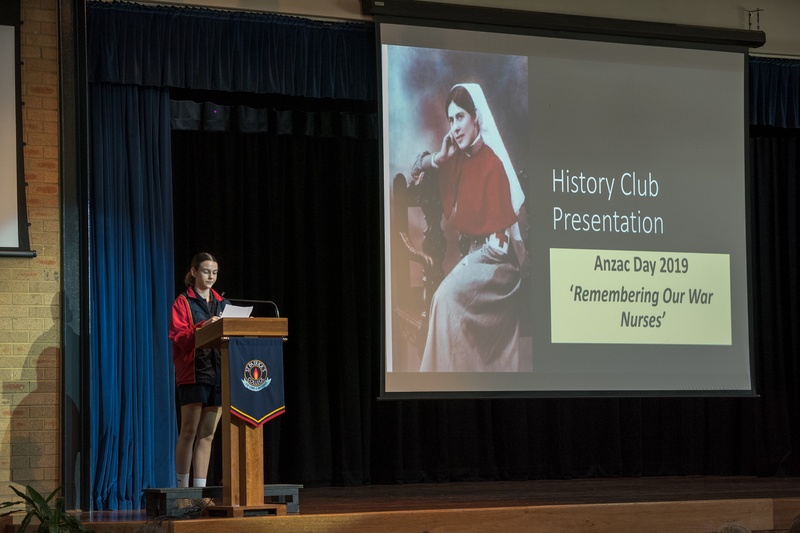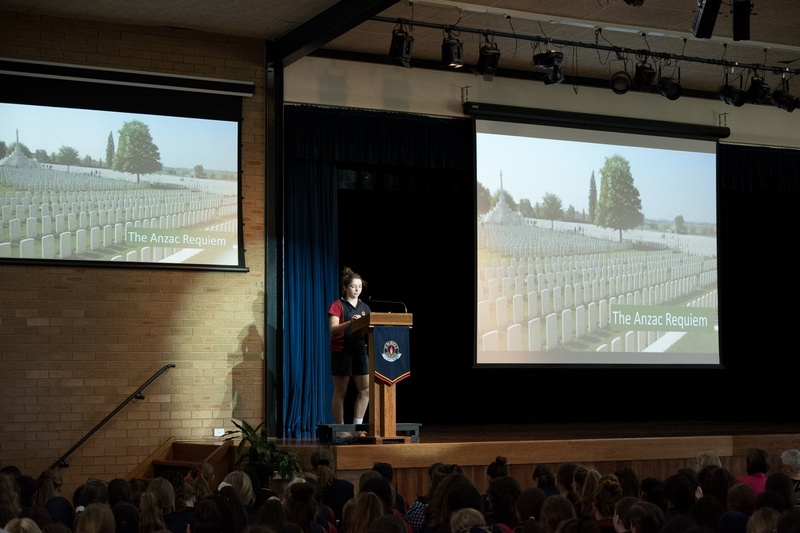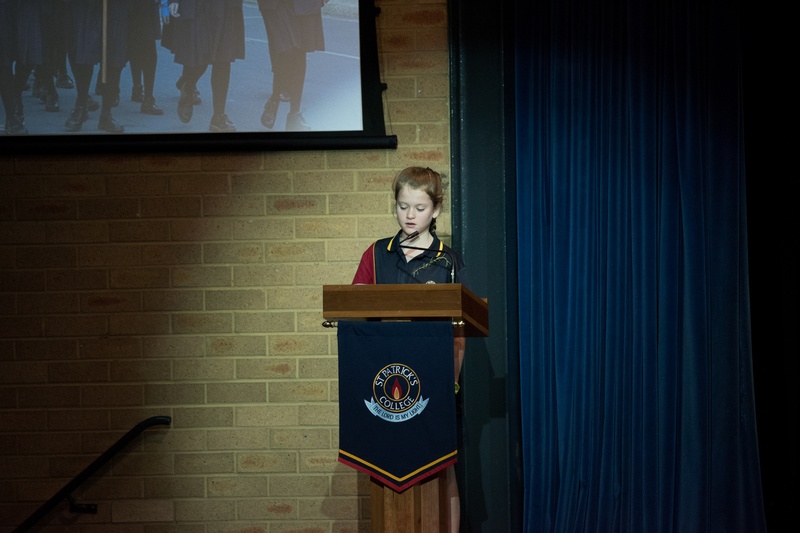History Club Anzac Presentation
Due to Anzac Day falling during the holidays, the History Club gave a presentation for Anzac Day at the recent College Assembly. The education theme for this year was Anzac nurses. The History Club are working on a historical display to go outside room H13 and will march on Anzac Day in Campbelltown.
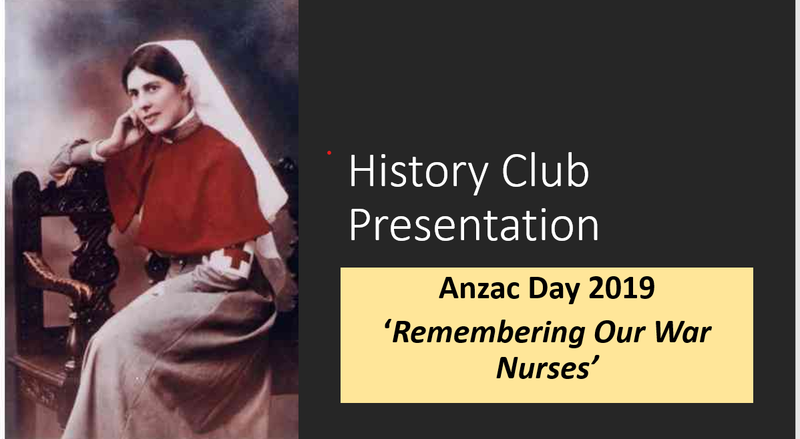
Olivia L began the presenation explaining that Anzac Day is a national day of remembrance to commemorate all those who served and died in all wars. She explained that on Anzac Day, Australians and New Zealanders wear a sprig of rosemary because it is an ancient symbol of ‘remembrance’ and because the plant grew at Gallipoli. She also read out the Prayer of Remembrance. Tess M read out the The Anzac Requiem written by Charles Bean in 1944, which is often read out at Anzac Day services. Maddison J introduced the theme of commemorating nurses and explained that Australian nurses were first deployed during the Boer War in 1898 as part of the Australian Nursing Service of New South Wales. Since then, they have been involved in every conflict where Australian troops have been deployed.
Abbey C presented a segment on the conditions for Australian nurses who served in World War I. In World War I over 3000 Australian women were deployed as nurses. Many had come from country hospitals and were not prepared for the carnage of modern warfare. They were continually short-staffed, plagued with a shortage of medical supplies and worked in primitive conditions. Nurses were not permitted on the front line. Many were stationed on hospital ships or hospital camps at Alexandria and Malta and later, at Lemnos Island. At Lemnos, the nurses were housed in tents and were subjected to extreme weather conditions and a shortage of food. Many developed dysentery. On the Western Front, nurses were stationed at casualty clearing stations in France and Belgium and were often subjected to gas and bomb attacks. Others served in rehabilitation hospitals in England. Twenty-five Anzac nurses died during World War I. Abbey went on to read some diary entries from nurses at Gallipoli and on the Western Front.
Emeline L in Year 7 read out 'A Prayer of Thanks' a poem/prayer written by an anonymous Australian soldier in World War I about the nurse who cared for him. The original is held in the Australian War Memorial. Mackenzie M, Dominique T and Mary K together presented a tribute to the nurses from Campbelltown who served in World War I: Eleanor Dagma Gjedsted, Ida Mary Graham, Clarice Elizabeth Green, Sister Elizabeth McRae, Elizabeth Chisholm Thomson and Ruth Allardyce Steel.
Layla E introduced the 'Remember' video made by Caroline A for last year's Armistice Centenary commemorations. The video was about how the History Club prepared for this ceremony and the word ‘remember’ in all the different cultural languages in our student and staff community.
Molly Q then discussed the role of nurses in World War II. Over 4,000 Australian nurses served during World War II in many theatres of war such as New Guinea and Europe. Under Japanese occupation, many Australian nurses were also held prisoner where they were malnourished and left to die of disease. Molly Q told the audience of the remarkable story of Vivian Bullwinkel, a nurse with the Australian Army Nursing Service. Zara H talked about one of our local nurses Sr Helen Haultain the Centaur was a hospital ship that left Sydney in May 1943 on its way to New Guinea. On that ship was Sr Helen Haultain, a nurse who lived on Cumberland Rd, Ingleburn, and had served at the Ingleburn Army Camp. The Centaur was marked with big red crosses to show it was a hospital ship. In war there is an assumed rule that hospital ships are not to be bombed by enemies. In the early hours of 14 May 1943 a Japanese submarine torpedoed the Centaur off the coast of Queensland and it sank within minutes. Sr. Haultain was killed, along with 266 others. Only one nurse survived the sinking.
Eve M brought the role of Australian nurses to more recent times by discussing the Vietnam War. The Vietnam War was different for nurses as new medical technology was available and patients could be transported quickly by the 'dust-offs'. It was not until the 1970s that men began joining the Australian military as nurses. This is when female nursing officers were finally given equal pay and were permitted to continue serving if they married and had children.
Bronwyn Z closed off the ceremony and paid tribute to the four World War I soldiers who have memorials in the Congregational Cemetery adjacent to the College - Herbert Harry Kitching, Stephen Longhurst, James Roughley Longhurst and Frank Jenner Nicol.
Every year St Patrick’s College has a contingent of students in the Anzac Day March in Campbelltown. This year, Anzac Day falls during the second week of our holidays. We would like to encourage any student who would like to represent the College in the Anzac Day march in Campbelltown to contact Mrs Musico Rullo for a permission note.
Fran Musico Rullo - HSIE Teacher

